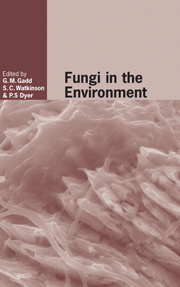Book contents
- Frontmatter
- Contents
- List of contributors
- Preface
- I Imaging and modelling of fungi in the environment
- II Functional ecology of saprotrophic fungi
- III Mutualistic interactions in the environment
- 8 Mycorrhizas and the terrestrial carbon cycle: roles in global carbon sequestration and plant community composition
- 9 Water relations in lichens
- 10 Development of the arbuscular mycorrhizal symbiosis: insights from genomics
- IV Pathogenic interactions in the environment
- V Environmental population genetics of fungi
- VI Molecular ecology of fungi in the environment
- Index
- References
8 - Mycorrhizas and the terrestrial carbon cycle: roles in global carbon sequestration and plant community composition
from III - Mutualistic interactions in the environment
Published online by Cambridge University Press: 03 November 2009
- Frontmatter
- Contents
- List of contributors
- Preface
- I Imaging and modelling of fungi in the environment
- II Functional ecology of saprotrophic fungi
- III Mutualistic interactions in the environment
- 8 Mycorrhizas and the terrestrial carbon cycle: roles in global carbon sequestration and plant community composition
- 9 Water relations in lichens
- 10 Development of the arbuscular mycorrhizal symbiosis: insights from genomics
- IV Pathogenic interactions in the environment
- V Environmental population genetics of fungi
- VI Molecular ecology of fungi in the environment
- Index
- References
Summary
Introduction
The mycorrhizal symbiosis is characterized by a reciprocal exchange of photosynthetically-fixed plant carbon in return for the main plant-growth-limiting nutrients, nitrogen or phosphorus. Studies of mycorrhizal functioning have focused on their roles in providing nutrients to plants, but their importance as a significant component of the terrestrial carbon (C) cycle has generally been overlooked. However, over 80% of plant species invest substantial amounts of their below-ground C flow into these fungal symbionts (Smith & Read, 1997; Leake et al., 2004). At the global scale, the annual C flux through soil respiration is ten times greater than fossil fuel combustion and recycles c. 10% of atmospheric CO2 (Raich et al., 2002). Roots and associated mycorrhizas are the single most important component of this flux. Knowledge of the mycorrhizal contribution to the C cycle is of increasingly paramount importance, as this component is likely to be among the most sensitive to ongoing anthropogenic disturbance of both C (Staddon et al., 2002) and nitrogen (N) biogeochemical cycles (Nilsson & Wallander, 2003).
The major biomes are dominated by plants with one of three kinds of mycorrhiza (Fig. 8.1), each of which is adapted to the particular vegetation and soil characteristics of the bioclimatic regions in which it is most important (Read et al., 2004). Central to understanding the contributions of mycorrhizas to the plant–soil–atmosphere continuum of the C cycle is appreciation of the properties and functions of these three major types of mycorrhiza and the ecosystems in which they are of greatest importance.
- Type
- Chapter
- Information
- Fungi in the Environment , pp. 161 - 184Publisher: Cambridge University PressPrint publication year: 2007
References
- 2
- Cited by



